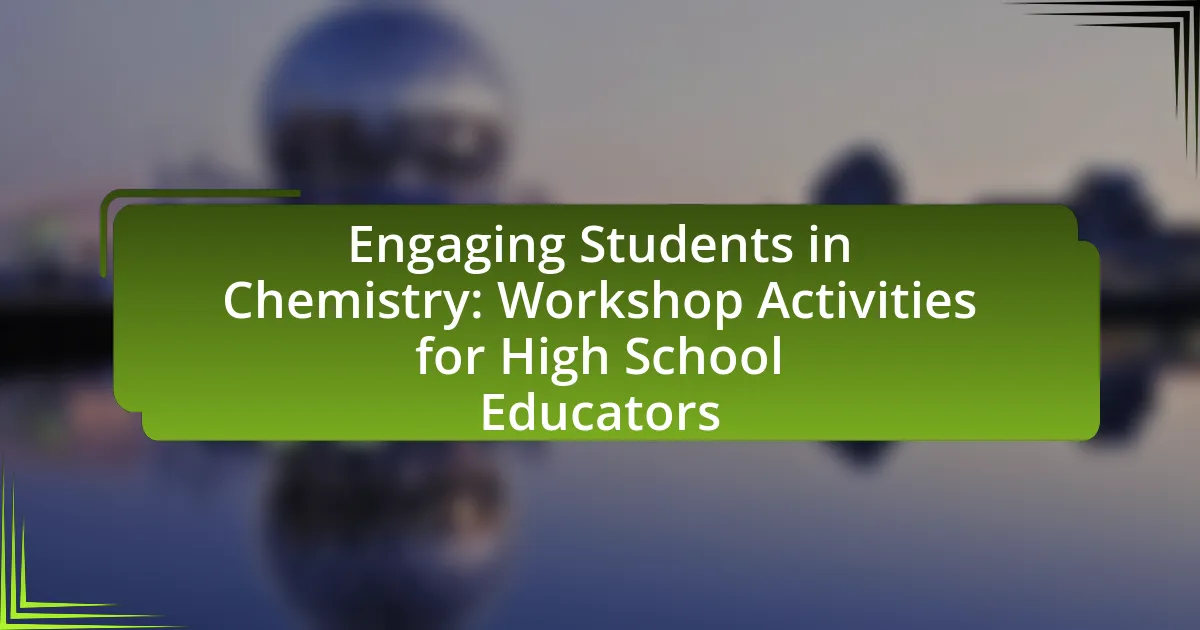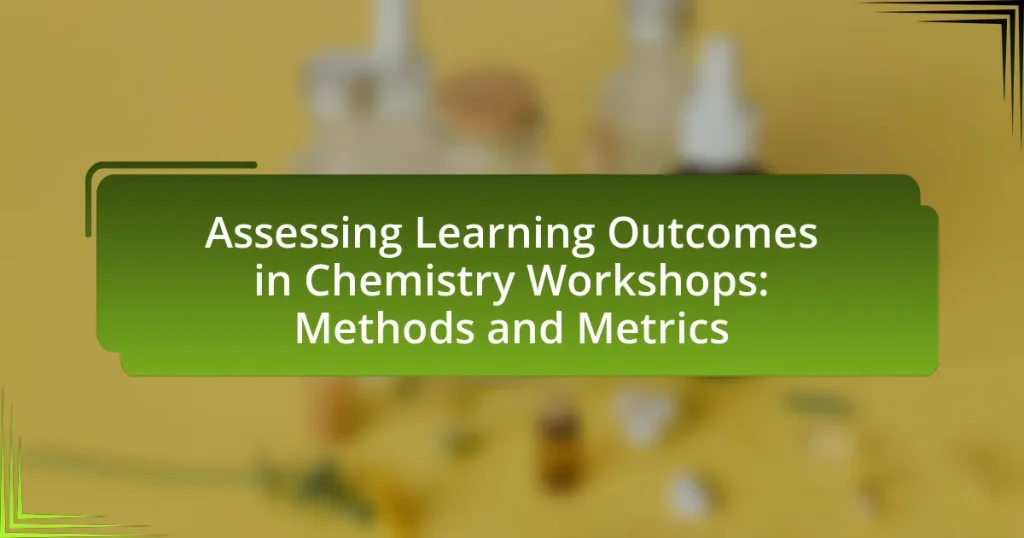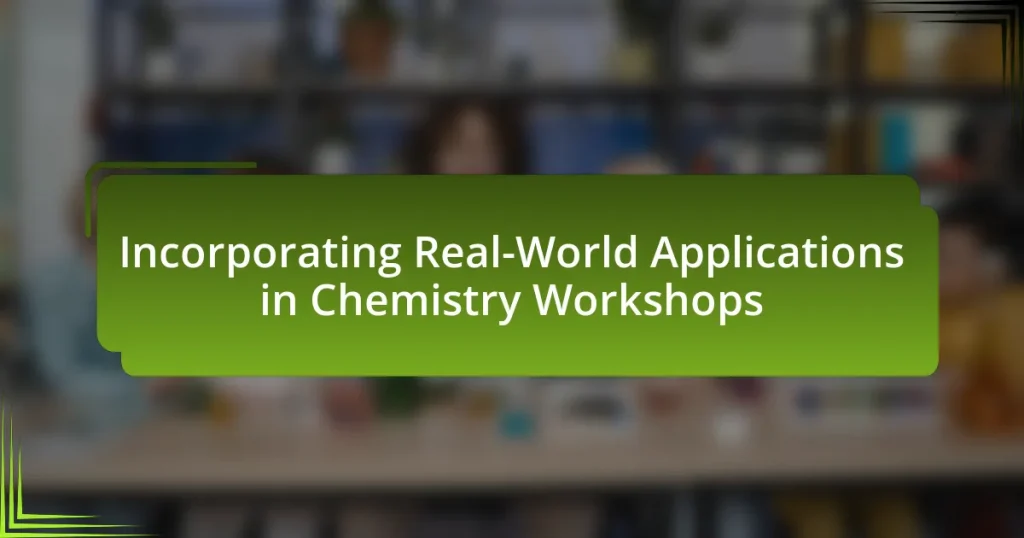The article focuses on effective strategies for engaging high school students in chemistry through hands-on experiments, real-world applications, and collaborative learning. It highlights the importance of active learning methods, such as laboratory experiments and project-based learning, which enhance student motivation and retention of chemical concepts. Additionally, the article discusses how these strategies cater to different learning styles and the significance of student engagement in improving academic performance and interest in STEM careers. It also outlines best practices for educators to design interactive workshops and assess their effectiveness, ensuring continuous improvement in chemistry education.

What are effective strategies for engaging students in chemistry?
Effective strategies for engaging students in chemistry include hands-on experiments, real-world applications, and collaborative learning. Hands-on experiments allow students to actively participate in the learning process, fostering curiosity and retention of concepts. For instance, conducting simple chemical reactions in the classroom can illustrate fundamental principles and spark interest. Real-world applications, such as discussing the role of chemistry in environmental issues or medicine, help students connect classroom learning to everyday life, making the subject more relevant. Collaborative learning, through group projects or peer teaching, encourages communication and teamwork, enhancing understanding and engagement. Research indicates that active learning strategies significantly improve student performance and interest in science subjects, as highlighted in studies by Freeman et al. (2014) in the Proceedings of the National Academy of Sciences.
How can hands-on activities enhance student learning in chemistry?
Hands-on activities enhance student learning in chemistry by promoting active engagement and facilitating experiential learning. When students participate in experiments and practical applications, they develop a deeper understanding of chemical concepts through direct interaction with materials and processes. Research indicates that students who engage in hands-on learning demonstrate improved retention of knowledge and higher levels of motivation. For instance, a study published in the Journal of Chemical Education found that students involved in laboratory activities scored significantly higher on assessments compared to those who learned through traditional lectures. This evidence supports the effectiveness of hands-on activities in fostering a more meaningful and impactful learning experience in chemistry.
What types of hands-on activities are most effective for high school students?
Hands-on activities that are most effective for high school students include laboratory experiments, project-based learning, and interactive simulations. Laboratory experiments allow students to apply theoretical knowledge in practical settings, enhancing their understanding of chemical concepts through direct experience. Project-based learning encourages collaboration and critical thinking as students work on real-world problems, fostering deeper engagement with the subject matter. Interactive simulations provide a safe environment for students to explore chemical reactions and processes, making abstract concepts more tangible. Research indicates that these types of activities significantly improve student motivation and retention of information, as evidenced by studies showing that students engaged in hands-on learning outperform their peers in traditional settings.
How do these activities cater to different learning styles?
Workshop activities in chemistry cater to different learning styles by incorporating a variety of instructional methods that address visual, auditory, and kinesthetic preferences. For instance, visual learners benefit from diagrams and videos that illustrate chemical processes, while auditory learners engage through discussions and lectures that explain concepts. Kinesthetic learners are actively involved in hands-on experiments, allowing them to physically manipulate materials and observe reactions. Research by Fleming and Mills (1992) on learning styles emphasizes the importance of diverse teaching strategies to enhance student engagement and retention, confirming that varied activities effectively meet the needs of all learners.
Why is student engagement important in chemistry education?
Student engagement is crucial in chemistry education because it enhances understanding and retention of complex concepts. Engaged students are more likely to participate actively in experiments and discussions, leading to deeper comprehension of chemical principles. Research indicates that active learning strategies, which promote student engagement, can improve academic performance by up to 50% in STEM subjects, including chemistry. This increased engagement fosters critical thinking and problem-solving skills, essential for success in scientific fields.
What impact does engagement have on student performance and retention?
Engagement significantly enhances student performance and retention. Research indicates that students who are actively engaged in their learning process demonstrate higher academic achievement and are more likely to persist in their studies. For instance, a study by Fredricks, Blumenfeld, and Paris (2004) found that increased engagement correlates with improved grades and lower dropout rates. Engaged students are more motivated, participate more in class, and develop a deeper understanding of the material, which ultimately leads to better performance and a greater likelihood of continuing their education.
How can engagement influence students’ interest in pursuing STEM careers?
Engagement significantly influences students’ interest in pursuing STEM careers by fostering a deeper connection to the subject matter. When students actively participate in hands-on activities, such as experiments and collaborative projects, they develop a greater appreciation for the relevance and application of STEM fields. Research indicates that students who engage in interactive learning experiences are more likely to express interest in STEM careers; for instance, a study by the National Science Foundation found that students involved in inquiry-based learning showed a 30% increase in their interest in STEM fields compared to those in traditional lecture-based settings. This demonstrates that engagement not only enhances understanding but also motivates students to consider future careers in science, technology, engineering, and mathematics.

What workshop activities can high school educators implement?
High school educators can implement hands-on laboratory experiments, interactive demonstrations, and collaborative group projects as workshop activities. These activities engage students by allowing them to apply theoretical concepts in practical settings, fostering a deeper understanding of chemistry. For instance, conducting experiments such as creating chemical reactions or exploring the properties of materials can enhance student interest and retention of knowledge. Research indicates that hands-on learning increases student engagement and improves academic performance, as evidenced by studies showing that students who participate in laboratory activities score higher on assessments compared to those who do not.
How can educators design interactive chemistry workshops?
Educators can design interactive chemistry workshops by incorporating hands-on experiments, collaborative group activities, and technology integration. Hands-on experiments allow students to engage directly with chemical reactions, enhancing their understanding through practical application. Collaborative group activities, such as problem-solving tasks or peer teaching, foster communication and teamwork skills while deepening comprehension of complex concepts. Additionally, integrating technology, such as simulations or virtual labs, provides students with innovative tools to visualize and manipulate chemical processes, making learning more dynamic and accessible. Research indicates that active learning strategies, including these methods, significantly improve student engagement and retention in science education.
What are the key components of a successful chemistry workshop?
The key components of a successful chemistry workshop include clear objectives, hands-on activities, effective facilitation, and participant engagement. Clear objectives ensure that both educators and students understand the goals of the workshop, which can lead to focused learning outcomes. Hands-on activities allow participants to apply theoretical knowledge in practical scenarios, enhancing retention and understanding of chemical concepts. Effective facilitation by knowledgeable instructors fosters an environment conducive to learning, encouraging questions and discussions. Lastly, participant engagement through interactive elements, such as group work or demonstrations, keeps attendees motivated and involved, which is crucial for effective learning in chemistry.
How can technology be integrated into chemistry workshops?
Technology can be integrated into chemistry workshops by utilizing digital tools such as simulations, interactive software, and online resources. These tools allow students to visualize complex chemical processes, conduct virtual experiments, and access a wealth of information that enhances their understanding of chemistry concepts. For instance, platforms like PhET Interactive Simulations provide free interactive math and science simulations, which have been shown to improve student engagement and comprehension in chemistry education. Additionally, using data collection tools like probeware enables real-time analysis of chemical reactions, fostering hands-on learning experiences.
What role do collaborative activities play in chemistry workshops?
Collaborative activities in chemistry workshops enhance student engagement and deepen understanding of chemical concepts. These activities promote teamwork, allowing students to share diverse perspectives and problem-solving approaches, which can lead to a more comprehensive grasp of complex topics. Research indicates that collaborative learning environments improve critical thinking skills and retention of information, as students actively participate in discussions and experiments. For instance, a study published in the Journal of Chemical Education found that students who engaged in collaborative projects demonstrated higher achievement levels compared to those who worked independently. This evidence underscores the significant role that collaborative activities play in fostering a productive learning atmosphere in chemistry workshops.
How can group projects enhance understanding of chemistry concepts?
Group projects enhance understanding of chemistry concepts by promoting collaborative learning, which allows students to engage in discussions, share diverse perspectives, and solve problems collectively. This interaction fosters deeper comprehension as students explain concepts to one another, reinforcing their own understanding. Research indicates that collaborative learning can improve retention of information and critical thinking skills, as evidenced by a study published in the Journal of Chemical Education, which found that students participating in group projects scored higher on assessments compared to those who worked individually.
What are some examples of collaborative activities for chemistry classes?
Collaborative activities for chemistry classes include group experiments, peer teaching sessions, and project-based learning. Group experiments allow students to work together to conduct chemical reactions, fostering teamwork and communication skills. Peer teaching sessions enable students to explain concepts to one another, reinforcing their understanding while developing presentation skills. Project-based learning involves students collaborating on research projects, where they investigate a chemistry-related topic and present their findings, promoting critical thinking and problem-solving abilities. These activities enhance engagement and deepen comprehension of chemistry concepts.

How can educators assess the effectiveness of workshop activities?
Educators can assess the effectiveness of workshop activities by utilizing participant feedback, pre- and post-workshop assessments, and observation of student engagement during the activities. Participant feedback, collected through surveys or interviews, provides direct insights into the perceived value and applicability of the workshop content. Pre- and post-workshop assessments measure knowledge gains and skill development, allowing educators to quantify learning outcomes. Additionally, observing student engagement, such as participation levels and enthusiasm during activities, offers qualitative data on the workshop’s impact. Research indicates that workshops incorporating these assessment methods lead to improved instructional practices and student outcomes, as evidenced by studies showing a correlation between participant satisfaction and increased student engagement in subsequent lessons.
What methods can be used to evaluate student engagement during workshops?
Methods to evaluate student engagement during workshops include observational assessments, surveys, and interactive activities. Observational assessments involve instructors monitoring student participation and body language during the workshop, providing real-time insights into engagement levels. Surveys can be administered before and after workshops to gauge students’ interest and understanding, with specific questions designed to measure engagement. Interactive activities, such as group discussions or hands-on experiments, allow educators to assess engagement through student collaboration and enthusiasm. Research indicates that these methods effectively capture the dynamics of student involvement, as evidenced by studies showing a correlation between active participation and learning outcomes.
How can feedback from students inform future workshop designs?
Feedback from students can significantly inform future workshop designs by identifying areas for improvement and highlighting effective teaching strategies. When students provide insights on workshop content, delivery methods, and engagement levels, educators can tailor future sessions to better meet learners’ needs. For instance, a study by Hattie and Timperley (2007) emphasizes that feedback is crucial for enhancing learning outcomes, as it allows instructors to adjust their approaches based on direct student experiences. By analyzing this feedback, educators can refine workshop activities, ensuring they are more interactive and aligned with students’ interests, ultimately leading to improved engagement and understanding in chemistry.
What metrics can educators use to measure learning outcomes?
Educators can use various metrics to measure learning outcomes, including standardized test scores, formative assessments, summative assessments, student portfolios, and classroom participation rates. Standardized test scores provide a benchmark for student performance against national or state standards, while formative assessments, such as quizzes and class activities, offer ongoing feedback on student understanding. Summative assessments, like final exams or projects, evaluate cumulative knowledge at the end of a learning period. Student portfolios showcase individual progress and mastery of skills over time, and classroom participation rates reflect student engagement and involvement in the learning process. These metrics collectively provide a comprehensive view of student learning and effectiveness of instructional strategies.
What best practices should educators follow for continuous improvement?
Educators should implement reflective practices, data-driven decision-making, and collaborative learning to ensure continuous improvement. Reflective practices involve regularly assessing teaching methods and student outcomes, allowing educators to identify areas for enhancement. Data-driven decision-making requires analyzing student performance data to inform instructional strategies, which has been shown to improve educational outcomes significantly. Collaborative learning encourages educators to share best practices and resources, fostering a community of support and innovation. Research indicates that schools employing these best practices see higher student engagement and achievement, as evidenced by studies from the Institute of Education Sciences, which highlight the positive correlation between teacher collaboration and student success.
How can educators adapt activities based on assessment results?
Educators can adapt activities based on assessment results by analyzing student performance data to identify areas of strength and weakness. For instance, if assessments reveal that students struggle with chemical reactions, educators can modify lesson plans to include more hands-on experiments that reinforce this concept. Research indicates that differentiated instruction, tailored to meet the diverse needs of learners, enhances engagement and understanding in subjects like chemistry. A study published in the Journal of Chemical Education found that when educators adjusted their teaching strategies based on formative assessments, student comprehension improved significantly, demonstrating the effectiveness of responsive teaching practices.
What resources are available for professional development in chemistry education?
Professional development resources in chemistry education include workshops, online courses, and professional organizations. Workshops, such as those offered by the American Chemical Society, provide hands-on activities and strategies for engaging students. Online platforms like Coursera and EdX offer courses specifically tailored to chemistry educators, covering innovative teaching methods and curriculum development. Additionally, organizations like the National Science Teachers Association provide resources, networking opportunities, and conferences focused on chemistry education, enhancing educators’ skills and knowledge in the field.



